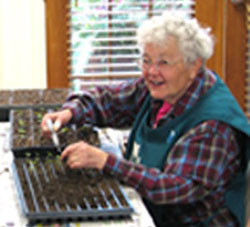 photo credit Cheyenne Botanic Gardens
photo credit Cheyenne Botanic Gardens
“The process of working in the Garden has a therapeutic effect: as the plants grow, so does the self-esteem of the older adult volunteers.”—Director, Cheyenne Botanic Gardens
The Cheyenne Botanic Gardens are unique not only for their use of solar and wind energy to enhance sustainability, but also because of their workforce, in which many volunteers are older adults, individuals with disabilities, and at-risk youth. According to Gardens staff, 90 percent of the physical labor is done by volunteers. The Gardens are an invaluable resource to the Cheyenne community, offering all the attractions of a beautiful environment, as well as occasions for structured, meaningful, and healthful activity for members of the community.
The Botanic Gardens are located in Cheyenne, Wyoming, the state capital and a city of approximately 60,000. With over 73,000 annual visitors, the Gardens are a valuable regional resource, which endeavors to “inspire, beautify, and enrich the High Plains through gardening, volunteerism, education, and stewardship.” The Gardens work to meet the following goals: exhibit diverse plants and landscapes; provide volunteer opportunities that enrich the lives of seniors, persons with disabilities, and at-risk youth; educate visitors; and create demonstrations of gardens, landscapes, renewable energy, and sustainable, earth-friendly approaches.
The Cheyenne Botanic Gardens were founded in 1977 as part of an initiative to build a nonprofit, solar-heated greenhouse. Construction was funded through the low-income assistance programs of Community Action of Laramie County, Inc., a local social service agency. In 1986, when the Gardens relocated to Cheyenne’s Lions Park, a new solar-heated greenhouse was constructed. In the early 1990s, the Gardens’ new nonprofit foundation arm, the Friends of the Cheyenne Botanic Gardens, underwrote the development of the Paul Smith Children's Village, a children’s garden with a focus on sustainability “past, present, and future.” The Gardens’ solar greenhouse also serves the broader community, as a source of food and bedding plants for the Gardens and the entire Cheyenne Parks system. All of the heat and half of the electricity for the greenhouse are solar, and the Children’s Village utilizes wind-powered pumps, electric turbines, and solar heating.
In addition to environmental sustainability, the Gardens take pride in social sustainability. Senior volunteers, working together with at-risk youth and adults with disabilities, have assumed responsibility for over 90 percent of the labor necessary to maintain the Gardens. In 2010 alone, 169 volunteers provided a total of 5,717 hours of work. This creative volunteer program provides a great service to participating seniors, who benefit from physical activity and social interaction. In working with the other volunteers, older adults form invaluable relationships with different members of the community. They are often able to build mentoring relationships with youth, a win-win for all. It is rare for seniors, youth, and disabled adults, who often lead separate lives, to be able to join in a shared effort. In addition, working in the Gardens has a therapeutic effect; as the plants grow, so does the self-esteem of volunteers.
Volunteers make it possible for the Gardens to operate with a small staff. In part due to low energy costs, its operations budget is relatively low. The Gardens rely on support from the community and derive nearly all funding from the Gardens’ foundation. The innovative approach of the Gardens has been acknowledged in the numerous awards for community leadership, including the President’s Volunteer Action Award from President Reagan, the Community Hero Award from Wyoming Governor Jim Geringer, and the Award of Merit from the American Public Garden Association. By providing a valuable asset to the community through an innovative approach to the traditional role of a botanic garden, the Cheyenne Botanic Gardens can count on continued community support for years to come.
To learn more visit their website at http://www.botanic.org